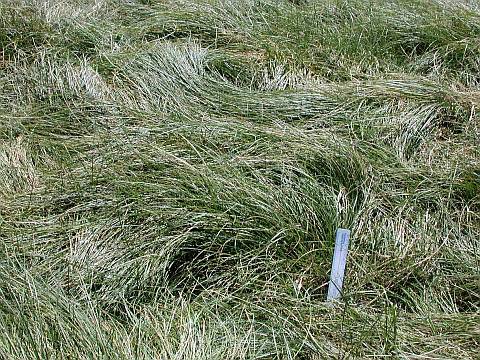In our yard in Oakland California, we have a section that was a sodded lawn when we moved in, but with the drought we stopped watering it. It’s now is a mixture of Oxalis pes-caprae (invasive clover), some “normal” grass, and a few other weeds. We’d like it to be more lawn-like without using that much water, California native, but still something we can walk on. After doing research and posting to the California Native Plant Society on Facebook, here are the options that I’ve found, in no particular order:
- Common Yarrow. Although it tends to be a bushier plant as an individual, when bulk-seeded and mowed it comes out sort of lawn like. Sources: San Marcos Growers, The Smarter Gardner, The Union, Larner Seeds.
- Carex pansa or C. praegracilis. These are bunchgrasses. Bunchgrasses normally would be too, well, bunch-y to walk on, but these two species tend to fall over and create a wavy effect. There seems to be some marketing confusion with these two, with a lot of what is sold as C. pansa is actually C. praegracilis. A downside is that it does not produce a lot of seeds so you have to buy plugs; I haven’t found a clear mail-order source.

Carex pansa, photo by Peggy A. Lopipero-Langmo, cc-by. - Festuca rubra, Red Fescue. This is a more “normal” fescue grass, but slower growing and lower maintenance. Needs cooler weather. Description by UC and seeds by Larner.
- Lippia repens aka Phyla nodiflora. Multiple recommendations for this one from Cal Native FB group. More of a groundcover than a grass, but can be walked on and sounds very tough. There are more than one article indicating that it is difficult to control and can easily spread beyond where you want it.
- UC Verde Buffalograss. This is a patented strain of Buchloe dactyloides developed by UC Davis/Riverside for “hot dry climates . . . uses up to 75% less water than a traditional fescue lawn . . . intended for full sun locations and elevations below 2000 feet.” That quote is from Takao nursery in Fresno which is selling it by mail, has clear pricing and detailed instructions. There’s also non-patented B. dactyloides. Takao says “UC Verde has a finer texture, later dormancy and earlier emergence and it is also a nearly seedless variety” as compared to the non-patent version. It is native to the Western US but not California.
- Agrostis pallens or “seashore bentgrass” or “dune bentgrass”. West Coast Turf says it is for cooler temperaturs and “withstands light foot traffic. It requires half the water of customary turf and half the mowing and maintenance. It can be mowed or be left to flop.” In many pictures it looks a little spiky to be something to comfortably walk on, although in this LA times story there is a more inviting photo and a landscaping company says “This is our No. 1 selling native grass.” A commenter from FB says “Works well as lawn, but will brown out at base if you let grow it too high and thick. But it is so nice to sleep in on a sunny day. Works well as a mown lawn if you follow the maintenance instructions.”
- Delta BlueGrass Co. has a good selection of native grasses as sod. Although I want seed, not sod, I consider it a vote of confidence for certain species that people are growing it in large quantities. Their “Native Bentgrass” is Agrostis pallens, “Delta Grassland Mix” is drought-tolerant native mix of Red Fescue, Deschampsia elongata, and Koeleria macrantha. “Native Mow Free” is a fescue combo that is mostly native but they make no claims about lower water use for it. Larner has seeds of all the Delta Grassland mix: here’s D. elongata and K. macrantha.
Leave a Reply